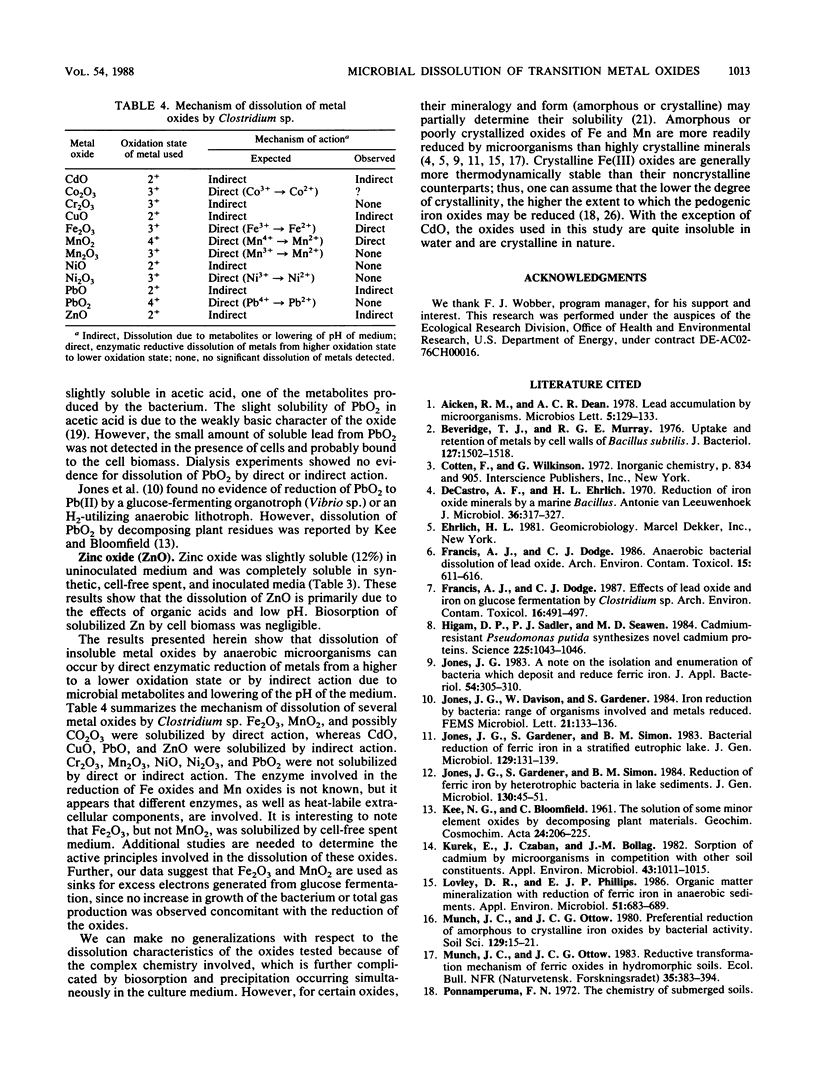Abstract
Anaerobic microbial dissolution of several crystalline, water-insoluble forms of metal oxides commonly associated with the waste from energy production was investigated. An anaerobic N-fixing Clostridium sp. with an acetic, butyric, and lactic acid fermentation pattern, isolated from coal-cleaning waste, solubilized Fe2O3 and MnO2 by direct enzymatic reduction; CdO, CuO, PbO, and ZnO were solubilized by indirect action due to the production of metabolites and the lowering of the pH of the growth medium. Extracellular heat-labile components of the cell-free spent medium obtained from cultures without oxide solubilized a significant amount of Fe2O3 (1.7 μmol); however, direct contact with the bacterial cells resulted in the complete dissolution (4.8 μmol) of the oxide. Under identical conditions, the cell-free spent medium solubilized only a small amount of MnO2 (0.07 μmol), whereas 2.3 μmol of the oxide was solubilized by direct bacterial contact. Reduction of Fe2O3 and MnO2 by Clostridium sp. proceeds at different rates and, possibly, by different enzymatic systems. Fe(III) and Mn(IV) oxides appear to be used as sinks for excess electrons generated from glucose fermentation, since there is no apparent increase in growth of the bacterium concomitant with the reduction of the oxides. Dialysis bag experiments with Co2O3 indicate that there is a slight dissolution of Co (0.16 μmol) followed by precipitation or biosorption. Although Mn2O3, Ni2O3, and PbO2 may undergo reductive dissolution from a higher to a lower oxidation state, dissolution by direct or indirect action was not observed. Also, Cr2O3 and NiO were not solubilized by direct or indirect action. Significant amounts of solubilized Cd, Cu, and Pb were immobilized by the bacterial biomass, and the addition of Cu2+ inhibited the growth of the bacterium.
Full text
PDF





Selected References
These references are in PubMed. This may not be the complete list of references from this article.
- Beveridge T. J., Murray R. G. Uptake and retention of metals by cell walls of Bacillus subtilis. J Bacteriol. 1976 Sep;127(3):1502–1518. doi: 10.1128/jb.127.3.1502-1518.1976. [DOI] [PMC free article] [PubMed] [Google Scholar]
- De Castro A. F., Ehrlich H. L. Reduction of iron oxide minerals by a marine Bacillus. Antonie Van Leeuwenhoek. 1970;36(3):317–327. doi: 10.1007/BF02069033. [DOI] [PubMed] [Google Scholar]
- Francis A. J., Dodge C. J. Effects of lead oxide and iron on glucose fermentation by Clostridium sp. Arch Environ Contam Toxicol. 1987 Jul;16(4):491–497. doi: 10.1007/BF01055272. [DOI] [PubMed] [Google Scholar]
- Higham D. P., Sadler P. J., Scawen M. D. Cadmium-Resistant Pseudomonas putida Synthesizes Novel Cadmium Proteins. Science. 1984 Sep 7;225(4666):1043–1046. doi: 10.1126/science.225.4666.1043. [DOI] [PubMed] [Google Scholar]
- Kurek E., Czaban J., Bollag J. M. Sorption of cadmium by microorganisms in competition with other soil constituents. Appl Environ Microbiol. 1982 May;43(5):1011–1015. doi: 10.1128/aem.43.5.1011-1015.1982. [DOI] [PMC free article] [PubMed] [Google Scholar]
- Lovley D. R., Phillips E. J. Organic matter mineralization with reduction of ferric iron in anaerobic sediments. Appl Environ Microbiol. 1986 Apr;51(4):683–689. doi: 10.1128/aem.51.4.683-689.1986. [DOI] [PMC free article] [PubMed] [Google Scholar]
- Tornabene T. G., Edwards H. W. Microbial uptake of lead. Science. 1972 Jun 23;176(4041):1334–1335. doi: 10.1126/science.176.4041.1334. [DOI] [PubMed] [Google Scholar]
- Tugel J. B., Hines M. E., Jones G. E. Microbial iron reduction by enrichment cultures isolated from estuarine sediments. Appl Environ Microbiol. 1986 Nov;52(5):1167–1172. doi: 10.1128/aem.52.5.1167-1172.1986. [DOI] [PMC free article] [PubMed] [Google Scholar]


